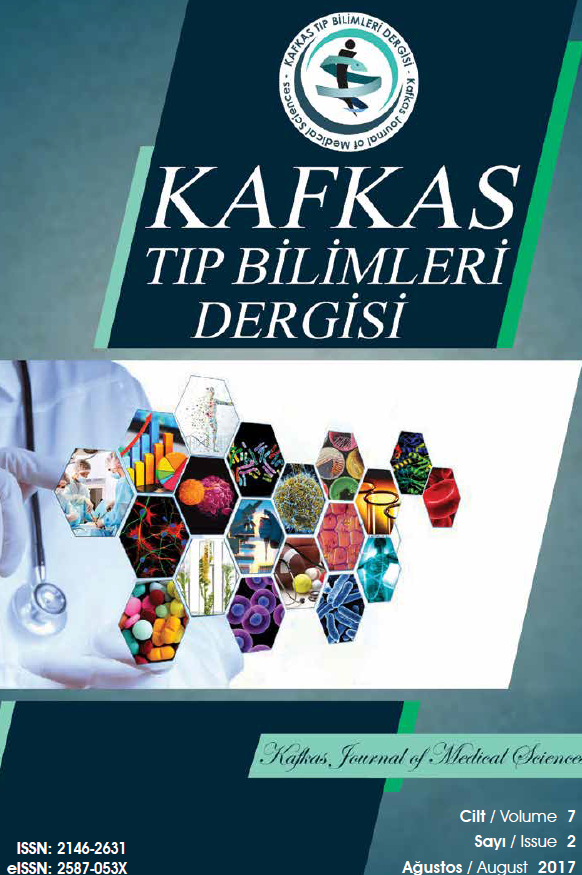Künt Toraks Travmalarında Travma Skorlaması ile Klinik Analiz
travma, künt göğüs travması, travma skorlaması
Clinical Analysis with Trauma Scoring in Blunt Thoracic Trauma
trauma, blunt thoracic trauma, trauma scoring,
___
- 1. Chen J, Jeremitsky E, Philp F, Fry W, Smith RS. A chest trauma scoring system to predict outcomes. Surgery 2014;156(4):988–94.
- 2. Pape HC, Remmers D, Rice J, Ebisch M, Krettek C, Tscherne H. Appraisal of early evaluation of blunt chest trauma: Development of a standardized scoring system for initial clinical decision making. J Trauma 2000;49(3):496–504.
- 3. Valderrama-Molina CO, Giraldo N, Constain A, Puerta A, Restrepo C, León A, et al. Validation of trauma scales: ISS, NISS, TRS and TRISS for predicting mortality in a Colombian population. Eur J Orthop Surg Traumatol 2017;27(2):213–20.
- 4. Ekpe EE, Eyo C. Determinants of mortality in chest trauma patients. Niger J Surg 2014;20(1):30–4.
- 5. Hildebrand F, GriensvenMv, Garapati R, Krettek C, Pape HC. Diagnostics and scoring in blunt chest trauma. Eur J Trauma 2002;28(3):157–67.
- 6. Wagner RB, Jamieson PM. Pulmonary contusion. Evaluation and classification of computed tomography. Surg Clin North Am 1989;69(1):31–4.
- 7. Tybursky JG, Collinge JD, Wilson RF, Eachempati SR. Pulmonary contusion: Quantifying the lesions on chest x-ray films and the factors affecting prognosis. J Trauma 1999;46(5):833–8.
- 8. Civil ID, Schwab CW. The Abbreviated Injury Scale, 1985 revision: A condensed chart for clinical use. J Trauma 1988;28(1):87–90.
- 9. Chapman BC, Herbert B, Rodil M, Salotto J, Stovall RT, Biffl W, et al. RibScore: A novel radiographic score based on fracture pattern that predicts pneumonia, respiratory failure, and tracheostomy. J Trauma Acute Care Surg 2014;80(1):95–101.
- 10. Perna V, Morera R. Prognostic factors in chest traumas: A prospective study of 500 patients. Cir Esp 2010;87(3):145–70.
- 11. Pressley CM, Fry WR, Philp AS, Berry SD, Smith RS. Predicting outcome of patients with chest wall injury. Am J Surg 2012;204(6):910–4.
- 12. Battistella FD, Benfield JR. Blunt and penetrating injuries of the chest wall, pleura, and lungs. In: Shields TW. General Thoracic Surgery. Fifth ed. Philadelphia: Williams and Wilkins; 2000;815–63.
- 13. Lo Cicero I, Mattox KL. Epidemiology of chest trauma. Surg Clin North Am 1989;69(1):15–9.
- 14. Çakan A, Yuncu G, Olgaç G, Alar T, Sevinc S, Ors Kaya S et al. Chest traumas: Analysis of 987 cases. Ulus Travma Derg 2001;7(4):236–41.
- 15. Kahraman C, Akcal Y, Emirogulları N, Elbeyli L, Sozuer E, Tasdemir K et al. Blunt thoracic trauma. Erciyes Tıp Dergisi 1995;17:318–24.
- 16. Dee PM. The Radiology of Chest Trauma. Rad Clin North Am 1992;30:291–306.
- 17. Asensio JA, Demetriades D, Rodriguez A. Injury to the diaphragm. In Mattox KL, Feliciano DV, Moore EE, ed. Trauma 4th ed. New York: McGraw-Hill; 2000:603–31.
- 18. Meteroglu F, Eren TS. Traumatic Diaphragmatic Ruptures. Toraks Cerrahisi Bul 2014;4(4):259–65.
- 19. Curtis K, Asha SE, Unsworth A, Lam M, Goldsmith H, Langcake M, et al. ChIP. An early activation protocol for isolated blunt chest injury improves outcomes, a retrospective cohort study. Australas Emerg Nurs J 2014;19(3):127–32.
- 20. Grubmüller M, Kerschbaum M, Diepold E, Angerpointner K, Nerlich M, Ernstberger A. Severe thoracic trauma - Still an independent predictor for death in multiple injured patients? Scand J Trauma Resusc Emerg Med 2018;26(6):1–8.
- ISSN: 2146-2631
- Yayın Aralığı: Yılda 3 Sayı
- Başlangıç: 2011
- Yayıncı: Kafkas Üniversitesi
Yüksek Seviyeli Radial Sinir Hasarı Sonrası Tendon Transferleri: Retrospektif Çalışma
En Ünlü Üç Betakoronavirüs Salgınıyla İlgili Bilimsel Verimlilik Analizi: SARS, MERS ve COVID-19
Serviks Kanserinde Lenf Nodu Metastazına Etki Eden Kliniko-Patolojik Faktörler
Ahmet Çağdaş ACARA, Sedat YANTURALI, Ömer CANACIK, Mustafa BOLATKALE
Acil Serviste İş Kesintileri, Nedenleri, Yönetimi, Sonuçları; Pilot Çalışma
Ilker AKBAŞ, Abdullah Osman KOÇAK, Fatma Özlem ÇAYLAK, Sultan Tuna AKGÖL GÜR, Meryem Betos KOÇAK, Zeynep ÇAKIR
Diyarbakır Yöresi 2012-2017 Yılları Arası Kanser Hastalarının Analizi
İbrahim İBİLOĞLU, Ulaş ALABALIK, Ayşe Nur KELEŞ, Gülay AYDOĞDU, Mustafa NACİR, Hatice SERTAKAN, Hüseyin BÜYÜKBAYRAM
Toplumda Prediyabet Riski ve Tanılama Yöntemleri: Güncel Ölçüm Araçlarına İlişkin Derleme
Tip 2 Diyabetes Mellitus Hastalarında HbA1c ile Serum Magnezyum Düzeylerinin Karşılaştırılması
Senan ARSLAN, Halil İbrahim ERDOĞDU, Eray ATALAY
Preterm Prematür Membran Rüptürü ile Komplike Gebeliklerde Amniyotik Membran İyileşmesi
